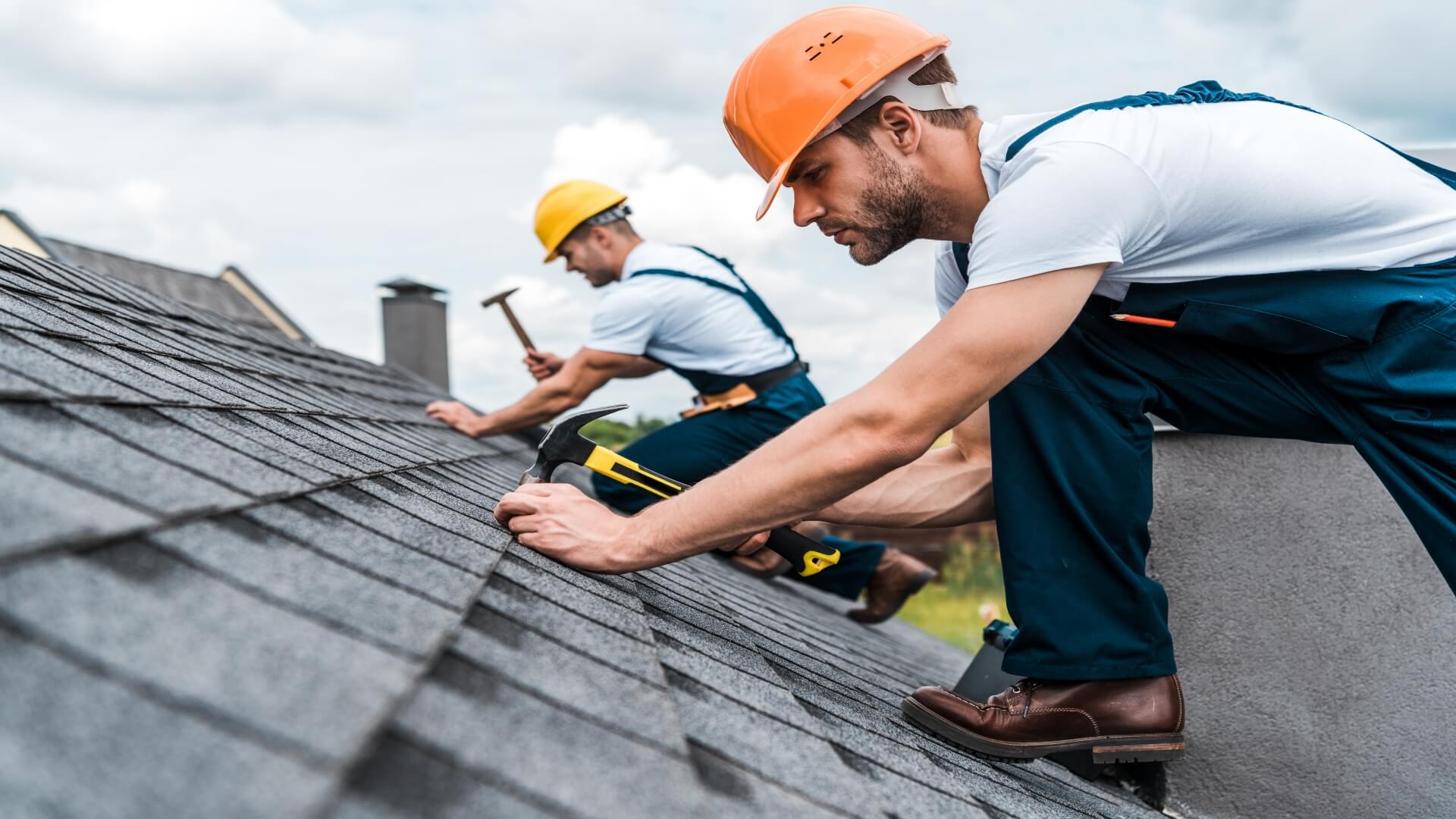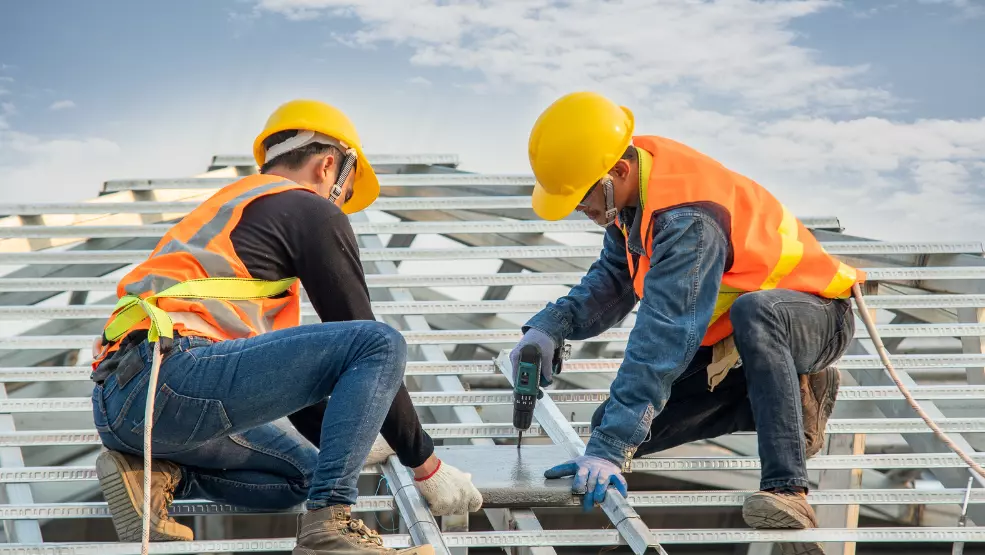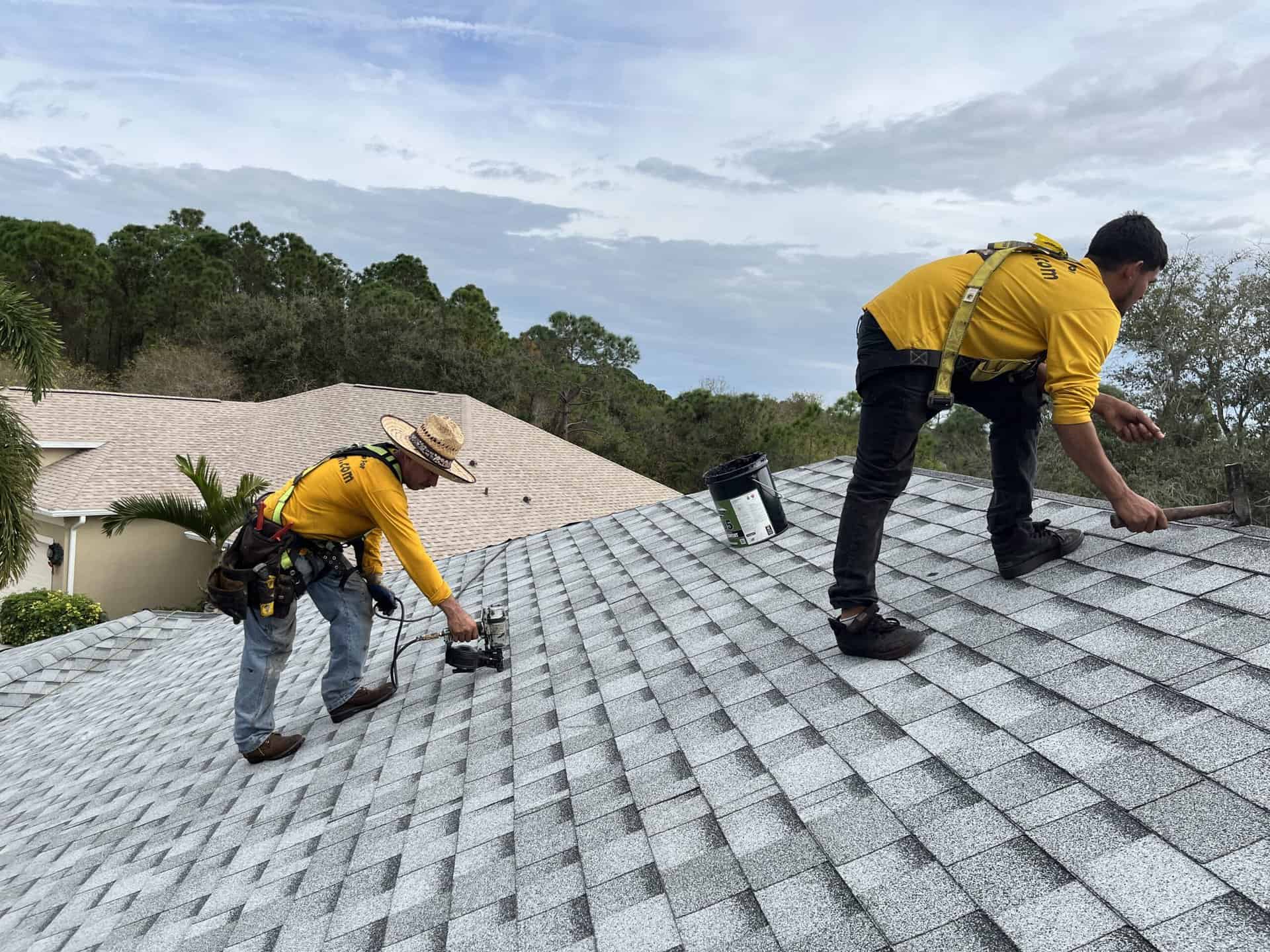Indications You Required Roof Covering Repair Service: Secure Your Financial Investment With These Easy Checks
Recognizing the signs that suggest a demand for roof covering fixing is important for protecting your building and investment. Usual indicators such as missing roof shingles, unexpected water stains, and granules building up in gutters can recommend underlying problems that, if left unaddressed, might rise into more major issues. Furthermore, signs like drooping areas or raised energy expenses can also aim to ineffectiveness or damages. To assure your roof remains in top problem and to stay clear of costly repair services, it is crucial to recognize these very early indication and act appropriately. What steps should you take next?
Missing or Damaged Roof Shingles
When reviewing the condition of your roofing, one of one of the most telling indicators of prospective concerns is the presence of missing out on or damaged roof shingles. Roofing shingles act as the very first line of defense against the aspects, and their integrity is vital for keeping the overall health and wellness of your roof - I&E Roofing & Construction, Inc.. A couple of missing out on roof shingles may appear small, however they can lead to significant water seepage, endangering the underlying structure and demanding more comprehensive repair services
Harmed tiles can manifest in various ways, including curling, fracturing, or blistering. Each of these problems can reduce the efficiency of your roofing system, allowing moisture to permeate and result in extra serious troubles. Roof Repair. It is vital to perform normal inspections, particularly after serious weather occasions, as high winds and hefty rain can aggravate roof shingles degeneration
If you determine missing out on or harmed tiles, it is advisable to deal with these problems immediately. While minor repair services may be workable for a property owner, comprehensive damage frequently calls for professional intervention. Timely activity can stop more problems and safeguard your investment, making certain the long life and efficiency of your roofing system.
Water Stains on Ceilings
Water spots on ceilings are usually clear indications of underlying water damages that requires prompt interest. Recognizing the source of these spots is crucial, as they can arise from various issues, consisting of roof leaks or plumbing troubles. Addressing the origin not just protects against more damages yet additionally shields the honesty of the home.
Identifying Water Damage

When examining for water stains, take note of both the shapes and size of the staining. Uneven forms might recommend continuous leaks, while more defined areas could suggest previous concerns. Furthermore, think about the location of the stains; discolorations near pipes components or exterior wall surfaces might offer ideas about prospective sources of the water intrusion.
It is likewise essential to examine the texture of the ceiling bordering the stains. Peeling paint or bubbling drywall can signal extensive moisture exposure, necessitating immediate interest. Regular examinations and timely action can assist prevent more serious water damage, shielding both the structural stability of the home and the financial investment it represents. Constantly get in touch with a specialist for a complete analysis if you find water stains on your ceilings.
Reasons for Stains
What variables add to the appearance of discolorations on ceilings? Water stains, frequently manifesting as stained patches, are mainly triggered by leaks in the roof or plumbing systems - I&E Roofing & Construction, Inc.. When wetness penetrates via roofing products or endangered pipes, it can accumulate and bring about visible discoloration on ceilings
One usual reason is damaged or missing tiles, which can allow rainwater to seep into the attic and, at some point, to the ceilings listed below. Additionally, inappropriate blinking around smokeshafts, vents, or skylights can be a significant resource of water breach. Pipes leakages, whether from malfunctioning pipelines or overflowing fixtures, can likewise produce discolorations, specifically in locations straight listed below shower rooms or kitchens.

Recognizing the source of the tarnish is crucial for efficient fixing. Ignoring these signs can bring about extra considerable damage, consisting of mold growth and architectural weakening, emphasizing the relevance of timely intervention to secure your financial investment.
Granules in Gutters
During routine examinations of your seamless gutters, the visibility of granules can be a significant indication of roof covering wear and tear. These little, sand-like particles are generally discovered externally of asphalt shingles, functioning as a protective layer against UV rays and weathering. In time, wear and tear can create these granules to remove, causing a range of problems that may compromise the integrity of your roofing.
If you observe a build-up of granules in your seamless gutters, it is vital to take this indicator seriously. The loss of granules might expose the underlying asphalt to the elements, increasing the risk of leakages and water damage. This situation not only endangers your roofing's lifespan but can also bring about expensive repair work otherwise attended to promptly.
To mitigate possible damage, it is recommended to examine your roofing regularly, specifically after extreme weather condition occasions. In addition, engaging a professional roofer to analyze the condition of your roof shingles can give valuable understandings. Early treatment is essential to preserving your financial investment and making certain the longevity of your roof. Bear in mind, granules in gutters are not an unimportant issue; they signal the demand for instant focus and possible repair.

Drooping Roofing Areas
Drooping roof locations can show significant architectural problems that call for immediate focus (Roofing Service). Noticeable deformities on the roofing system's surface, incorporated with the visibility of water discolorations inside the home, are essential caution signs that must not be overlooked. Addressing these issues promptly can stop additional damages and costly repairs
Noticeable Roof Deformities
Exactly how can homeowners determine possible issues with their roofs? One of the most telling indications is noticeable roof deformities, especially drooping locations. A sagging roofing system may appear as dips or contours, suggesting underlying architectural troubles that can jeopardize the integrity of the entire roof covering system. Property owners need to perform normal assessments, seeking any recognizable irregularities in the roofline.
A number of variables can contribute to visible deformities, including water damage, inappropriate installment, or the weight of accumulated snow and debris. If a roofing system appears to sag, it might suggest damaged rafters or trusses, which can result in a lot more severe issues if left unaddressed. A sagging roofing system not only threatens the structural security of the home however can also cause expensive repair service expenses if the trouble escalates.
If drooping or other visible defects are observed, it is a good idea to consult a professional roofer. They can examine the situation, determine the root cause of the sagging, and suggest appropriate repair service options. Timely treatment is essential to secure your investment and assure the long life of your roof covering.

Water Spots Inside Home
The presence of water discolorations inside the home often signifies prospective problems with the roof, particularly in areas where sagging has been observed. These discolorations typically indicate that water is penetrating with the roof material, which can bring about substantial architectural damage if left unaddressed. Sagging roofing system locations may be triggered by a variety of aspects, including poor assistance, collected wetness, or the degeneration of roof covering products.
When you observe water stains, it is crucial to explore the source of the moisture. Look for indicators of sagging in the roof framework, as this can exacerbate the problem. Commonly, sagging locations can trap water, leading to leakages and additional damages. Additionally, it is important to review the age of the roof covering; older roofings are a lot more vulnerable to deterioration, enhancing the chance of leaks.
Trigger action is needed to reduce damages. Seek advice from a qualified roof covering specialist to analyze the circumstance and recommend ideal fixings. Overlooking water discolorations and drooping can lead to costly repair services and jeopardize the stability of your home. Secure your financial investment by addressing these indicators prior to they rise right into a lot more serious troubles.
Increased Power Costs
An unanticipated spike in energy costs can commonly signify underlying problems with your roofing system. When your roofing system is jeopardized, it can lead to substantial air leaks, permitting conditioned air to leave and unconditioned air to penetrate your home. This ineffectiveness pressures your heating and cooling down systems to work harder, causing increased power intake and higher energy costs.
One typical culprit is harmed or missing roof shingles, which can subject your home's interior to the components. Furthermore, inadequate insulation because of roofing system damages can add to power loss. If you discover a regular increase in your power costs without a matching adjustment in usage routines, it is essential to examine potential roof-related issues.
Normal roofing examinations are crucial for identifying problems before they intensify right into expensive fixings. Look for noticeable indicators of wear, such as sagging areas, splits, or spaces. These may show that your roof is no more providing the essential obstacle versus the components. Resolving these issues without delay can help restore your home's energy efficiency and shield your investment in the future. If you suspect a trouble, consult a roofing expert for a thorough evaluation.
Mold or Mildew Growth
Mold or mildew growth on your ceiling or walls can be a clear indicator of roof-related issues, particularly when wetness infiltrates your home. These fungi grow in wet atmospheres and can pose significant wellness threats, consisting of respiratory problems and sensitive reactions. Their presence commonly recommends that your roof may be endangered, enabling water to seep in through leaks or gaps.
To assess the scenario, look for dark areas or staining on surface areas, usually in areas near the roofline or where water could build up (I&E Roofing & Construction, Inc.). In addition, check for any water spots, peeling paint, or soft places in your ceiling or wall surfaces, which may indicate continuous dampness issues
If you observe mold and mildew or mold, it is necessary to act rapidly. Not only can proceeded moisture damage your home's structural stability, however it can also lead to pricey repairs down the line. Involving an expert roofer can help identify the resource of the trouble, whether it's harmed roof shingles, incorrect air flow, or other problems. Routine evaluations and upkeep can aid prevent mold growth and protect your investment, making certain a risk-free and healthy and balanced living environment.
Age of the Roofing system
Evaluating the age of your roof covering is essential in determining its general problem and potential need for fixings. The majority of roof covering materials have a particular life expectancy, usually ranging from 15 to 30 years, relying on the kind of product made use of. Asphalt roof shingles, for example, typically last about twenty years, while metal roofings can sustain for 40 years or more. As roof coverings age, they become a lot more prone to harm from weather, bugs, and various other environmental variables.
Normal assessments are necessary for roofs older than 15 years. Indications of wear, such as split or curling tiles, missing out on tiles, or corrosion on metal surface areas, indicate that your roof might require instant attention. In addition, inner signs and symptoms like water discolorations on ceilings or walls can indicate underlying issues connected to an aging roof.
If your roofing system is approaching its expected lifespan, consider seeking advice from an expert roofing professional for an extensive analysis. They can offer insights on repair alternatives or suggest a substitute if essential. Aggressive monitoring of an aging roof covering can prevent costly damage to your home and warranty that your investment continues to be protected.
Regularly Asked Concerns
How Commonly Should I Inspect My Roof Covering for Damages?
Routine roof evaluations are vital for maintaining the stability of your home. It is suggested to evaluate your roofing at the very least two times a year, ideally in the springtime and fall, to identify any type of prospective problems beforehand. In addition, after severe weather events, such as hefty storms or hailstorm, a thorough inspection is suggested. Attending to minor damages promptly can protect against costly repair work and extend the life-span of your roof system considerably.
Can I Fix My Roof covering Myself?
While it is feasible to repair your roofing on your own, it is important to examine your abilities and the intricacy of the damages. Minor problems, such as replacing a couple of tiles, might be convenient for a DIY fanatic. Substantial repair services or architectural problems usually call for expert know-how to guarantee safety and security and compliance with structure codes. Always prioritize your security and think about consulting a roofing expert for extensive damage or if you are unpredictable concerning the repair services.
What Are the Typical Reasons For Roofing Leaks?
Common sources of roof leaks include harmed tiles, which can take place because of age or extreme weather, and improperly secured vents or blinking that may permit water infiltration. Furthermore, stopped up gutters can site here cause water backup, resulting in leakages. Structural problems, such as drooping roof coverings or jeopardized underlayment, likewise add to this issue. Normal examinations and upkeep are vital to determine these vulnerabilities and avoid expensive damage to your residential or commercial property.
Just How Can I Pick a Reputable Professional Roofer?
Selecting a trusted roofer includes comprehensive research and examination. Beginning by looking for referrals from trusted sources and checking on the internet testimonials. Confirm the contractor's licensing, insurance policy, and experience in roof projects comparable to your own. Request thorough quotes and contrast them for transparency. Additionally, ask about warranties and post-installation assistance. A respectable contractor must communicate plainly and show professionalism and reliability throughout the process, ensuring your financial investment is well safeguarded.
What Is the Typical Lifespan of Different Roof Materials?
The typical lifespan of roof materials varies significantly. Asphalt tiles normally last 15 to 30 years, while steel roofs can sustain 40 to 70 years. Timber drinks usually have a life expectancy of 20 to 40 years, whereas clay or concrete floor tiles can exceed half a century with appropriate upkeep. Lastly, artificial roofing products might supply longevity similar to typical choices, commonly enduring 30 to 50 years. Recognizing these lifespans aids in preparing for upkeep and substitute.